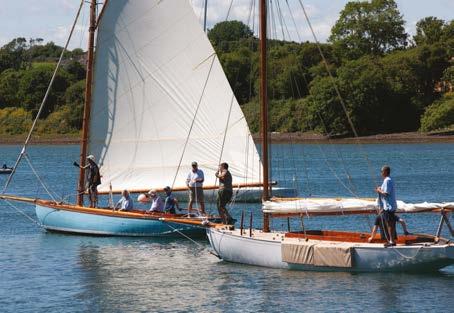


















































































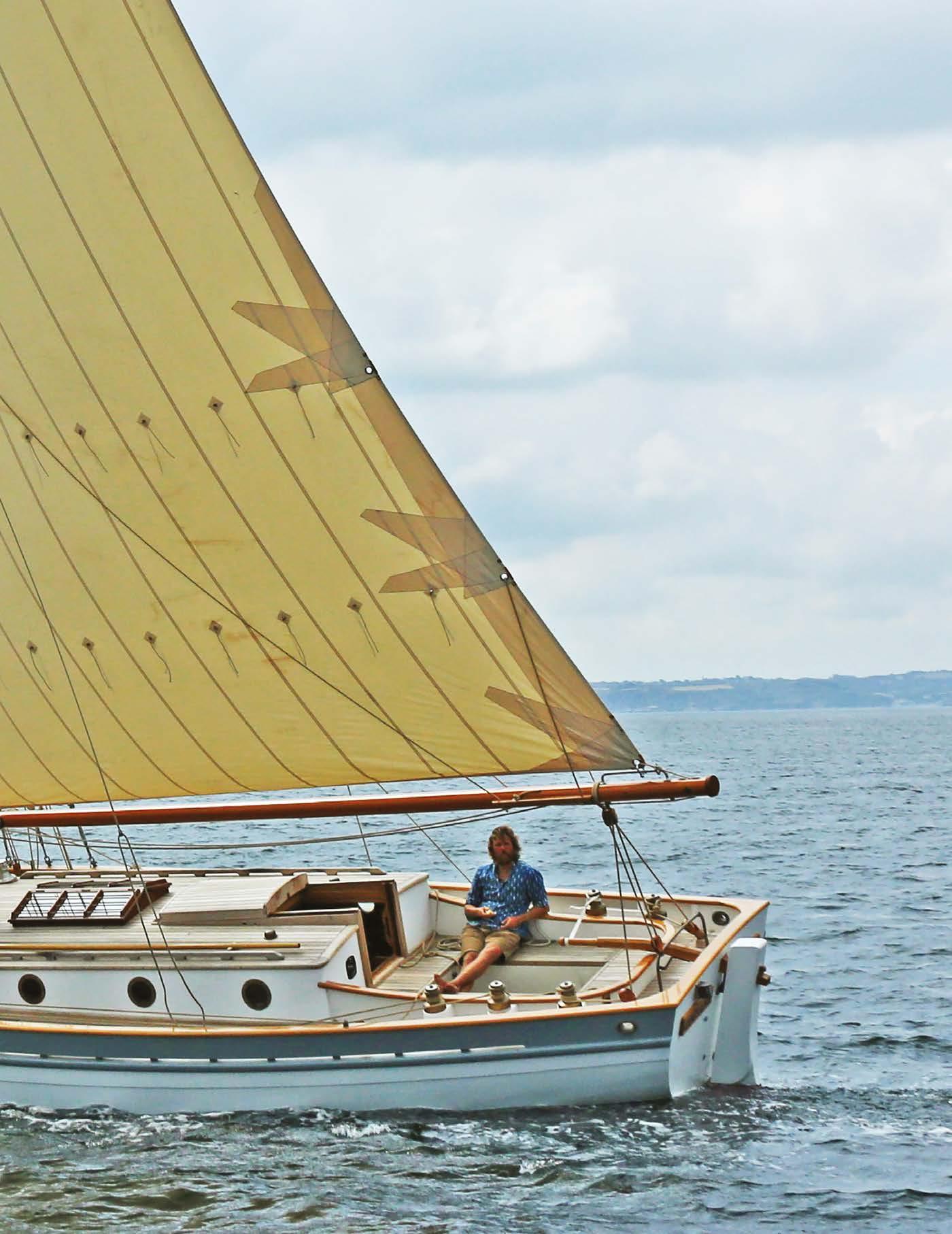 WORDSAND PHOTOS NIGEL SHARP
WORDSAND PHOTOS NIGEL SHARP
have to have a passion for wooden boats and be slightly mad to commission a brand-new one these days,” said Simon Wisker, owner of the new gaff cutter Constance. “You are making a personal investment in preserving traditional skills without getting it back in financial terms.”
Simon began sailing in the early 1970s when his father built a Mirror dinghy. For several years he and his family sailed this boat, and then later a Wayfarer, in Poole harbour near their home, and also on family holidays on the Percuil River, near St Mawes in Cornwall. Having continued to sail a bit at university in Exeter and then in Aberdeen, he built a 14ft (4.26m) clinker dinghy and took his own children sailing in the Lake District and on the west coast of Scotland. Ten years ago, retirement brought him back to Exeter, from where he went on holiday to St Mawes, which is where his interest in gaff cutters began.
Seeing the 1895 Falmouth working boat Florence on the harbour beach having a scrub in readiness for Falmouth Sailing Week about 10 years ago, he chatted to one of her skippers, Bill Handley. Florence belongs to a syndicate, and when it became apparent that there was a share available, Simon agreed to buy one. This resulted in frequent journeys between Exeter and St Mawes, and Simon often found himself leaving his crew mates to enjoy a post-race beer or two in St Mawes Sailing Club while he drove home.
He and his wife Kay briefly considered buying a small holiday cottage in St Mawes until he began to think that the answer might be to have a boat, maybe even to build a new one. He initially envisaged a boat small enough to sail on his own, something like a 20ft (6m) Mevagissey tosher, and camping on board under a boom tent. “But Kay said that she didn’t really want to camp on a boat,” said Simon. “She wanted something bigger that was really comfortable for her and the dog.” Although he started to look at the possibility of buying a secondhand boat – including, at one stage, a Bristol Channel pilot cutter – it wasn’t long before he found himself going in a different direction.
Below: Constance under construction at Gweek Classic Boatyard

Facing page: Constance under sail o St Anthony’s Lighthouse
Inset: Ben Harris making the point that Constance can sail herself
For some time Simon had been following the career of boatbuilder Ben Harris, and might have been interested in his appeal for volunteers to help build the Ed Burnett gaff cutter Panacea (CB366 to 372) were it not for the distance between Exeter and his workshop near Falmouth. Simon contacted Ben who told him that Alva, the gaff cutter, which he had built for himself in 2011 (CB286) was for sale. “We went to look at her and could see that she was a lovely boat,” said Simon, “but Ben convinced us that she would be no use to us at all and what we really needed was a brand-new boat, which he could build.”
Some time ago Ben took the lines off Curlew, the Falmouth Quay Punt made famous by the ambitious exploits of Tim and Pauline Carr, and had made no secret of his desire to build a boat to these lines. But at 28ft (8.5m) LOD she was quite a bit smaller than the boat that Simon and Kay now envisaged – it was becoming apparent that their accommodation needs would necessitate a hull more like 34ft (10.4m) – and so naval architect Jack Gifford was brought in to help with the project. Jack put Curlew’s lines on his computer, and analysed some of her key parameters such as her shape, ballast ratio, and centre of buoyancy coefficients “just to try to see why this boat had proved herself as such a well-behaved sea boat, and to try to characterise her shape,” he told me. When he initially scaled up the lines to 34ft he found that this resulted in too heavy a boat. “So she required a bit of pairing down in the mid body section to bring her back to around 12 tonnes, which is what you would want a non-working gaff cutter of that size to displace,” he said. He also used various characteristics of Alva and the Ed Burnett Ivy Green, which were reference boats that Simon admired. Jack drew the sail plan but with input from both Simon and Ben, “with no particular reference yachts but just trying to pull in ideas from various rigs we had seen.”
The question of where to build the new boat soon resolved itself when Ben found out that the shed at Gweek Classic Boatyard, in which he had been temporarily storing Alva, was available for a longer term.
During Simon’s earliest discussions with Ben, he made it clear that he would like to play a hands-on role in the build of the boat. It took a little while before they agreed how that should work, but then Simon’s involvement began at the very beginning, with the lofting. Initially Jack thought that he would provide CAD drawings for the moulds and so on, and so it wouldn’t be necessary to do any lofting, but Simon was particularly keen to do much of this himself, albeit under Ben’s close supervision. As it turned out, it was of great benefit, because Ben, Jack and Simon were able to look down at the full-size lofted lines from a mezzanine floor, from which they could see some small imperfections and from which they all agreed that it would be advantageous to make small modifications to the sheer and the freeboard. “It was definitely a collaborative process of design, which was very enjoyable,” said Ben. “It was a real pleasure to do that,” added Jack. “It isn’t always possible but, as Ben must be
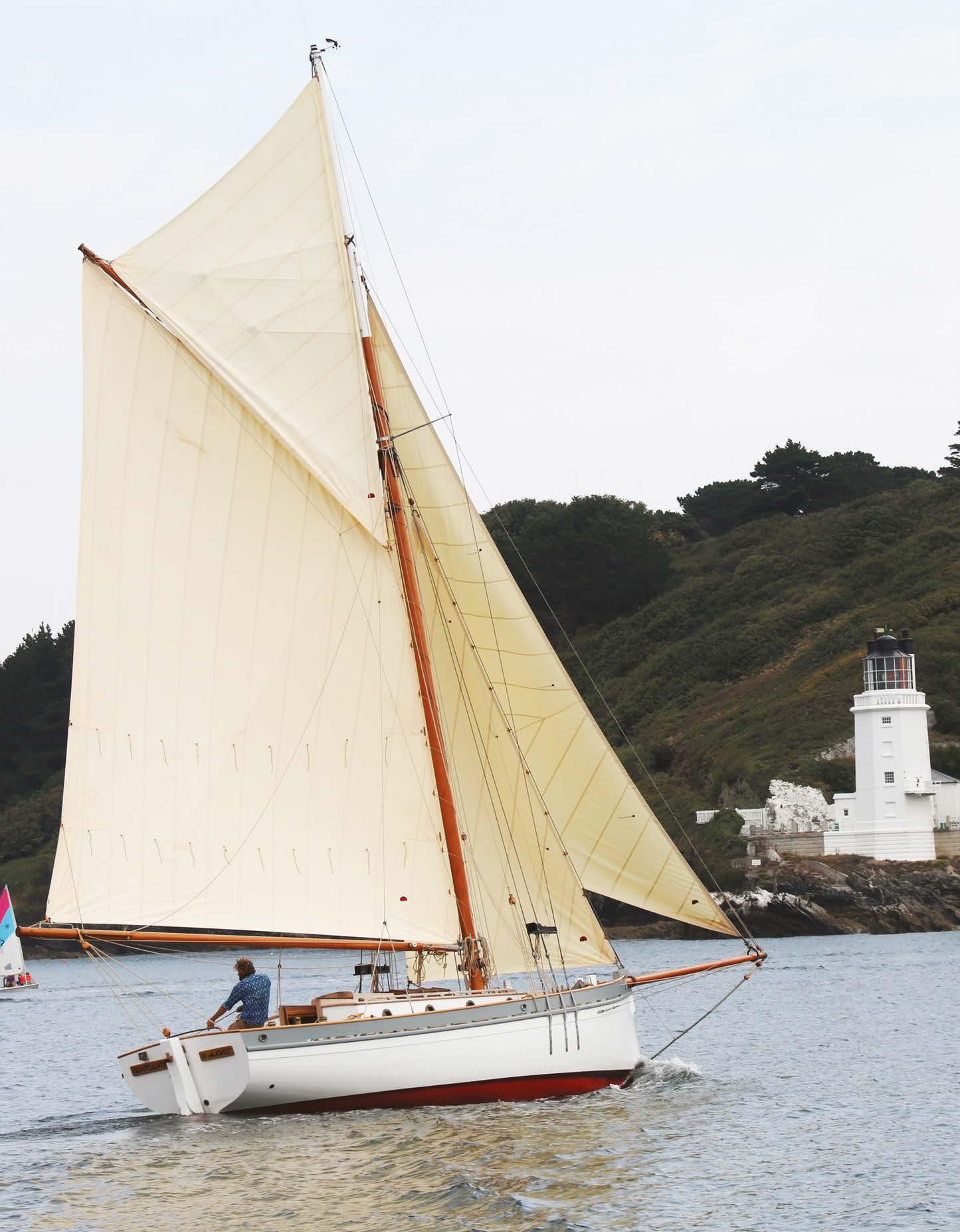

the absolute closest boatbuilder to my house, it was quite easy to do so!”
Constance’s hull was built from oak and larch. Oak was used for the keel, stem, sternpost, deadwoods, sawn frames, steamed timbers, the garboards and the next four planks up, and the sheer strake and next plank down; the remaining 14 planks are larch, all of them full length.
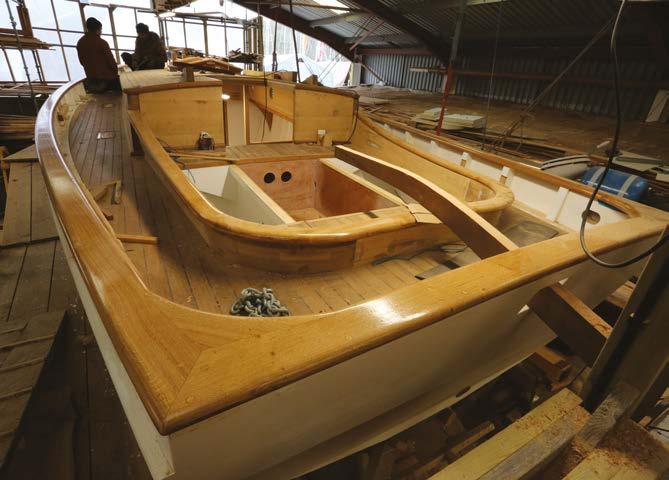

Ben had sourced the oak for the keel (max width 22in x 8in) about three years previously from SH Somerscales in Grimsby, and much of the other oak had been sourced even earlier than that, locally from the Tregothnan Estate on the banks of the Truro River. About three quarters of the sawn frames are in single futtocks. “We had exactly the right shapes to be able to do that,” said Ben. “So that makes her lighter as well as stronger.”
Throughout most of the length of the boat there are three steamed timbers (2in x 1¼in) between each pair of sawn frames but in the mast area, where there is a greater concentration of sawn frames, there is just one. Simon remembers going to Somerscales “with a tape measure and rough drawings on the hottest day in 2019” to select the larch to be used for the planking. The majority of planking is 1¼in thick and the sheer strake is 1½in. Everything was fastened with aluminium bronze bolts or copper clenches.
Ben and his team cast the five-tonne lead keel themselves, pouring the molten lead into a wooden mould bound with steel “to make sure it wasn’t going to burst open or anything – it looked like some kind of Gothic horror sarcophagus buried in the ground.” They happened to do it on a really hot day and Ben said “it was like being in the pits of hell.” Afterwards they complied with a long-standing boatbuilding tradition by rewarding themselves with a barrel of beer. The ballast keel was bolted to the wood keel with 10 x ¾in aluminium bronze bolts into galleries in the lead.
The beamshelf (6in x 2in amidships and tapering at the ends) and the deck beams (laminated for the coachroof and solid for the foredeck and side decks) are all oak. The deck itself consists of two layers of ½in yellow cedar (the lower one fore-and-aft, the upper one at 45 degrees, and glued together with resorcinol), sealed on top with glass and epoxy, and then with a 5/16in
Above: Fitting the shutter plank
Below: Finishing the deck details
Facing page, clockwise from top left: The teak for the decking was reclaimed from a 1920s cruise ship; Ben Harris’s builder’s plate; Traditional teak skylight over the saloon; The Fife rail around the mast; The forepeak; View of the galley from the chart table; Mainsheet block; Goosenecks
thick laid teak deck with oak covering boards. Ben favours this sort of subdeck rather than plywood as cedar is “more or less impervious to rot, and if you have any water ingress, it is always localised. It doesn’t spread through the solid wood, unlike plywood which tends to wick moisture through its many layers.”
The teak for the decking, the 1½in thick coamings and for the traditional skylight on the coachroof, had been reclaimed from a 1920s cruise ship which had been scrapped. “I chanced upon a local chap who had been bequeathed a load of it by his dad,” said Ben. “He had used most of it to floor his entire house and I offered to remake his floors in oak in return for the teak, but he said it was too much hassle.” But he still had a number of unused 15ft x 5½in x 2½in boards, which Ben was able to buy from him, albeit with some former fastening holes and ingrained iron stain in them, some of which is now visible in the skylight. “But I think that’s fine,” said Ben, “because it tells a story of where it came from.”
Although Jack produced comprehensive drawings for the interior design, “quite a few alterations were made in situ with Simon just holding up bits of wood in different places and just sketching it out on bits of wood,” said Ben, “to make sure that everything would be comfortable just for them.” The layout from the companionway going forward consists of the chart table to port (with an oilskin locker aft of it) and galley to starboard; seating to port and starboard with a folding table between, a pilot berth outboard to port and bookshelves outboard to starboard; a wood-fired heater to starboard and then a passageway with the heads compartment to port; and then the fo’c’s’le with a berth to port and a wide shelf to starboard. All of the interior joinery is made up of oak and white painted tongue-and-groove larch, and has a light airy feel to it. Constance’s interior generally feels surprisingly spacious for her length and has comfortable standing headroom throughout.
The engine is a Beta 35hp diesel; the engineering and electrical installation was done by Andrew Cox Marine, the instrumentation by BT Marine (Electronics); the stainless steel water and fuel tanks were fabricated by Keefe Engineering, and the Hobbit stove was supplied by Salamander Stoves in Devon.
Ben and his team also made the spars, all in Douglas
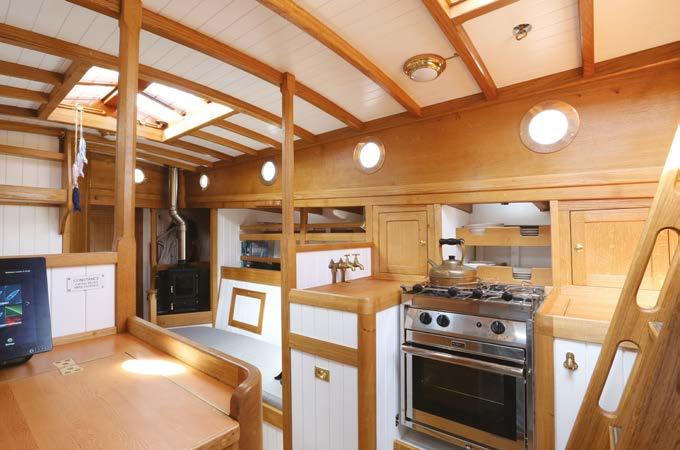

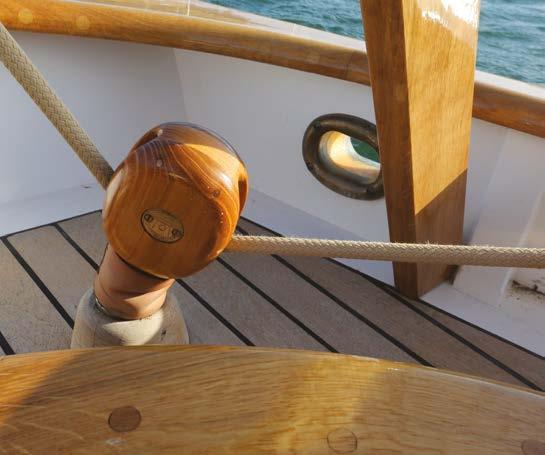


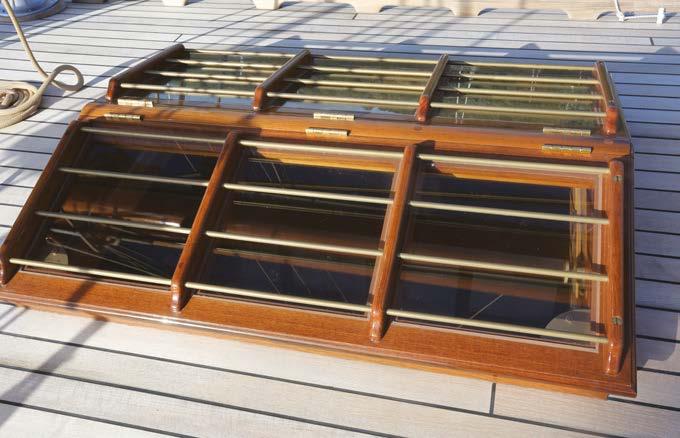

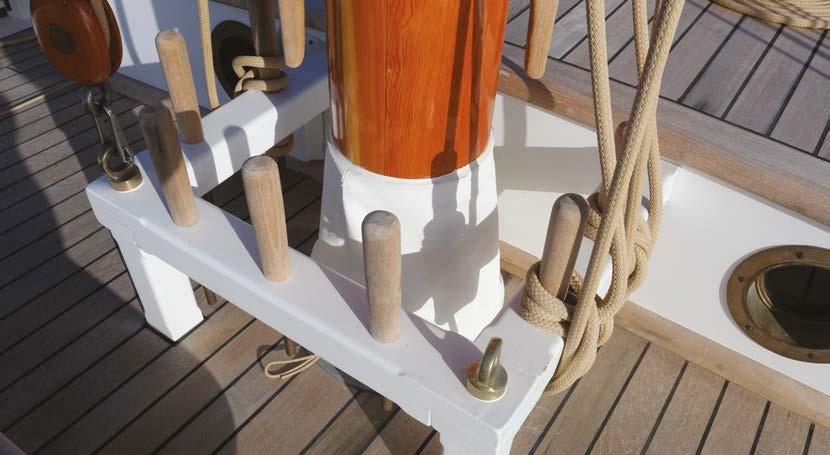
fir with a hollow gaff and the others solid. John Albrecht made up the rigging and many of the stainless steel fabrications; Colin Frake supplied much of the galvanised hardware and the blocks; the self-tailing winches are from Australian company Hutton Arco and many other deck and rig fittings came from Davey & Co and Toplicht. The sails are by Ratsey & Lapthorn. Throughout the build of the hull, Simon spent two or three days a week working with Ben and his core team of Pete Paxton, James Pardo and Josh Neely “doing whatever I was told to do”. But 11 days after the shutter plank was fitted the first Covid lockdown began and, as Simon’s circumstances then put him in a medically vulnerable category, that forced the end of his hands-on involvement. “As I am a perfectionist I was initially concerned that I would be frustrated not being involved in the build,” he said. “But whenever I managed to visit I was never disappointed with the workmanship or the decisions Ben had made. I completely trusted the way he and his team worked.” With the intention of remaining at least remotely involved, Simon planned to build Constance’s clinker tender but, after losing his workshop when he and Kay sold their house, he was unable to do so. The tender was then built by Josh, alongside Constance. Constance’s build started in September 2019 with an original plan to launch sometime in 2021. However, Covid restrictions and consequent increases in lead times for materials and equipment held things up, and
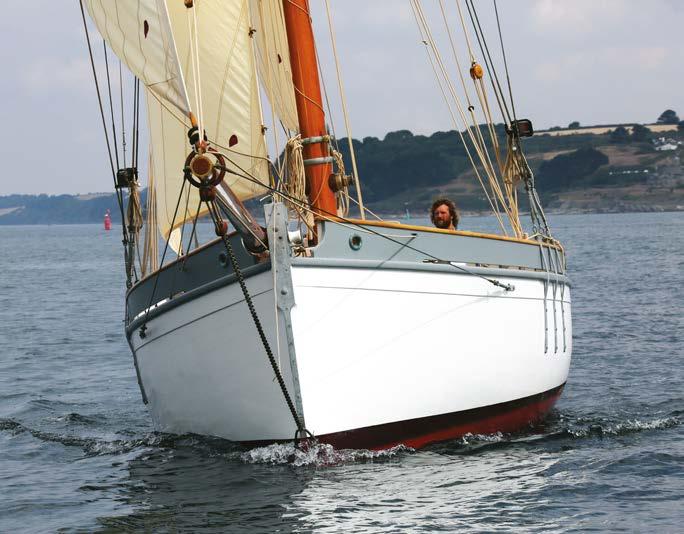
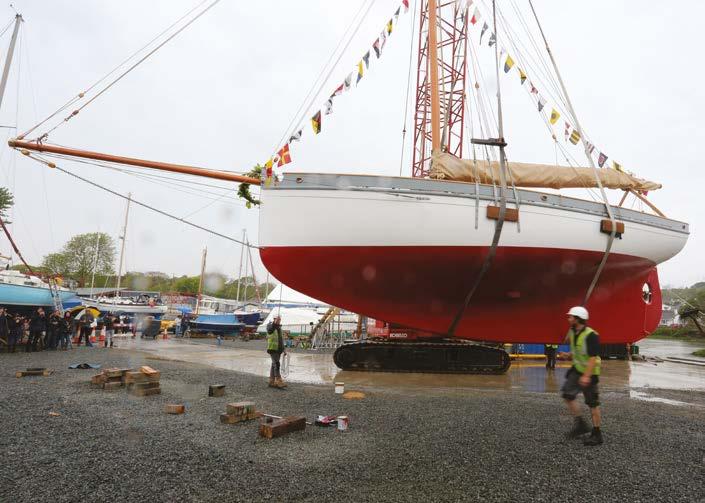
Above, left: Launching at Gweek in the rain
Above, right: Early sea trials
Below, left: Simon (grey tee) on the helm with son George (yellow tee) and boatbuilder Ben
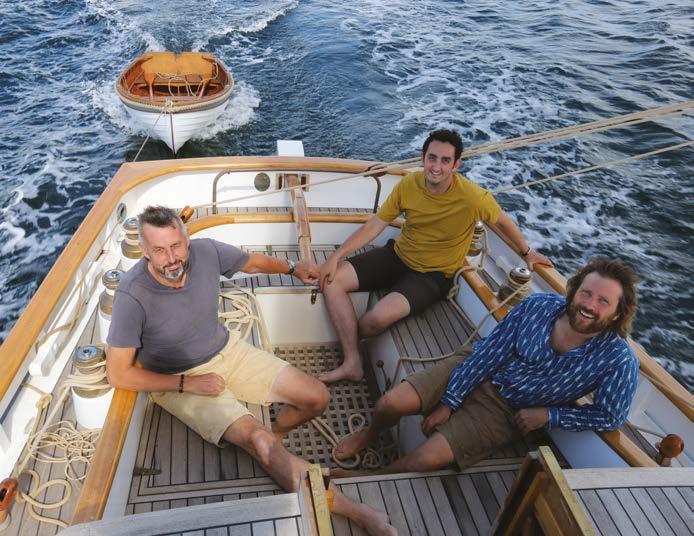
Below, right:
Under way in light winds
so a decision was made to “slow down and get her done properly,” said Simon. She was eventually launched on a rainy day in May 2022.
When I asked him about his plans for Constance, Simon seemed embarrassed – and unnecessarily so – to admit that he hasn’t got anything particularly ambitious in mind, at least not in the immediate future. He sensibly realises he has little experience handling a boat of this sort – Florence is about half the size in displacement terms and, although he regularly crews on her, he only occasionally takes the helm on the way to and from races – and so he sees the first season or two as a time to slowly get to know Constance before he starts thinking about going further afield. He is mindful of the fact that Kay “isn’t a super keen sailor” and so, in addition to sailing plans, he is looking forward to “just being aboard – with the wood burner on it is fabulous to be in that cabin,” he said.
What will be of great benefit in getting to know Constance is that Ben has gone to great lengths to make her as easy as possible to sail shorthanded. She is a well-balanced boat and so it is possible to carefully tie the tiller to a windward winch and then leave her to sail herself in a straight line for significant periods. Tacking singlehanded is relatively straightforward with a little practice and Simon’s confidence with that is already growing. One thing is for absolute certain, and that is that wherever he takes her, near or far, he can hold his head high – very high – with pride.





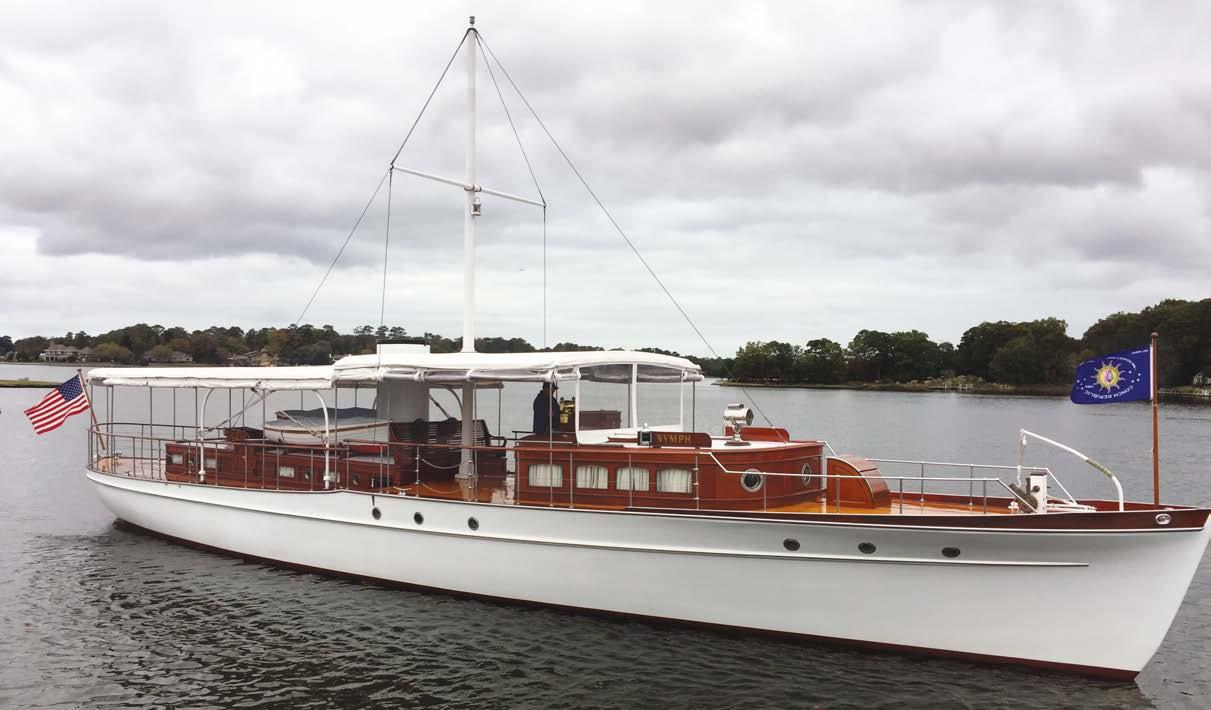
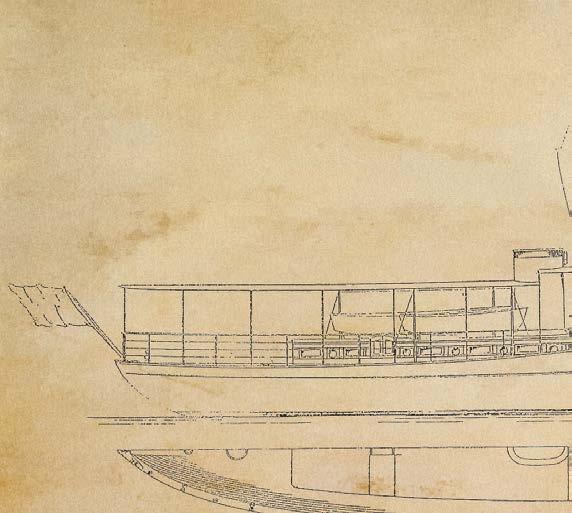
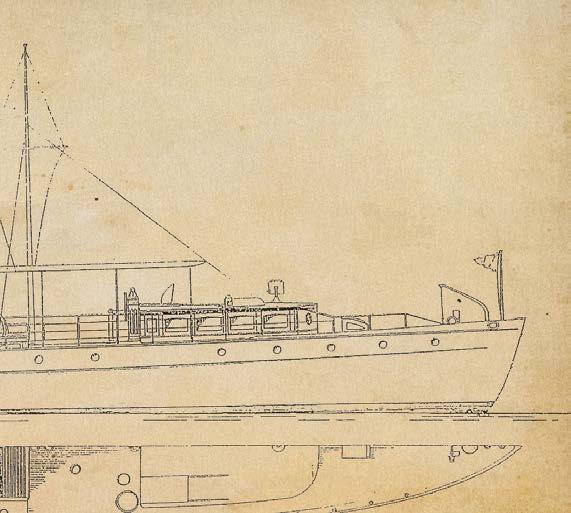








A total of 10 of the best 12-Metre yachts on the Baltic circuit, including nine classics and one modern 12-M turned out in Flensburg for the annual Robbe & Berking Sterling Cup recently.

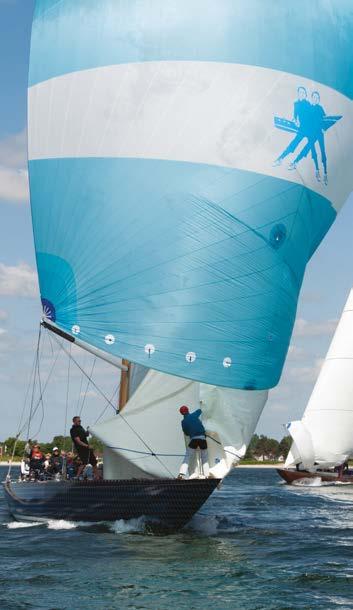
Besides the 12-Metres, the organisers always invite a selection of other yachts such as Dragons, 6-Ms and 8-Ms but this year in addition, thirteen 5.5-Ms sailed the class Open German Championships, and a dozen classic Rivas provided an extra classic atmosphere.
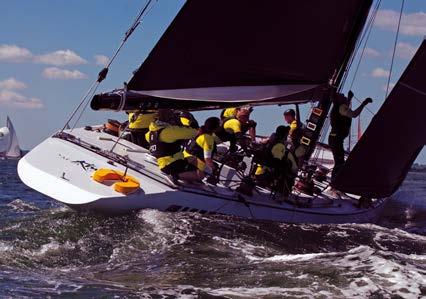
For years, the top five or six of the Baltic 12-M fleet has been a fairly evenly matched group but with the Olin Stephens-designed Vim from 1939 regularly topping the list as the winner. However, this year newcomer Northern Light not only shook up the competition but has also given fresh impetus to the already immensely popular 12-M scene in the Baltic.
Together with the tune-up races in Dyvig, Denmark the weekend before, no fewer than 16 races were sailed. With so many closely-matched yachts in this class, the lead changed constantly throughout the races, but over the course of the event it became clear that Northern Light had somehow found an edge in boat speed and tactics, resulting in four firsts, two seconds and one third.


Like Vim, she was built by Nevins in New York and designed by Olin Stephens. She is a year older than Vim, but clearly already steeped in Stephens’ design genius. She was only the second 12-M designed by Stephens, the first being her almost identical sister ship Nyala. Another newcomer that performed well was Nini Anker, formerly known as Siesta and built in 2015 by Robbe & Berking to a design by Johan Anker.
Part of the strength of the growth of the Baltic 12-Metre fleet is because racing is mainly done with amateur sailors and the owners helm the boats themselves. The support of Patrick Howaldt (the owner of Vim and vice-president of the International Twelve Metre Association) and Oliver Berking over the years in various projects has of course contributed significantly to the growth of the class.
The racing for the Sterling Cup was much more exciting than the Low Points Scoring System indicates. In the final results for example, four of the nine yachts had scored a first place. In many races the di erence between first or second place was a matter of seconds. But there is no doubt that Northern Light was the deserved winner with only 13 points over nine races. Nini Anker was on her heels with 17 points and Vim in third place with 28 points. It should be mentioned that Vim’s end result was seriously hampered by the fact that a crew member was injured in race two and she withdrew and did not start the third race that day.
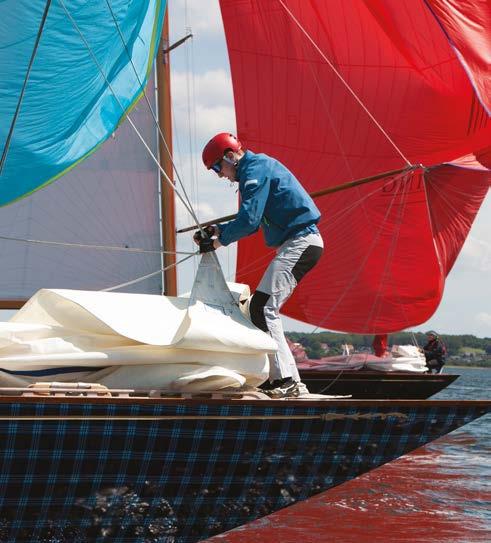

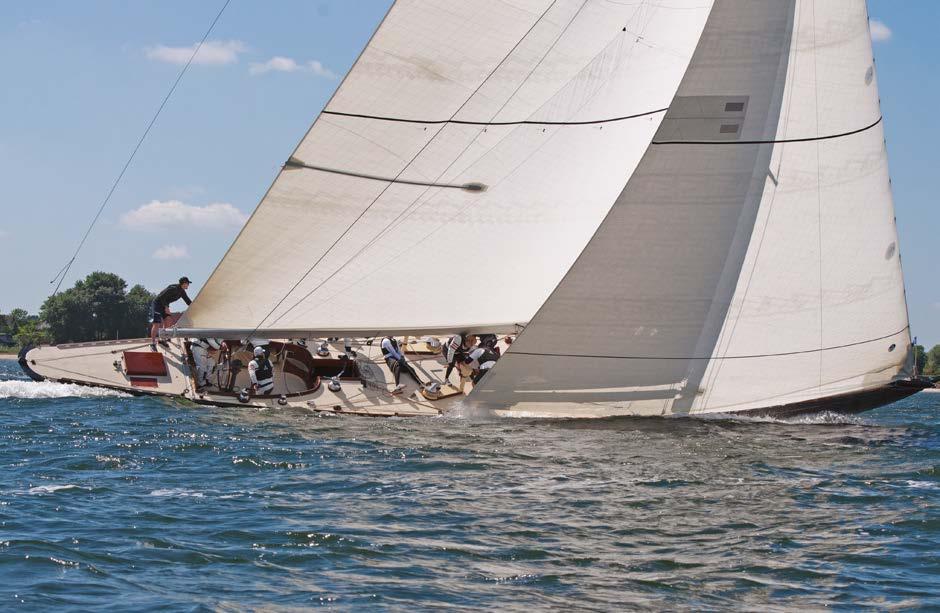
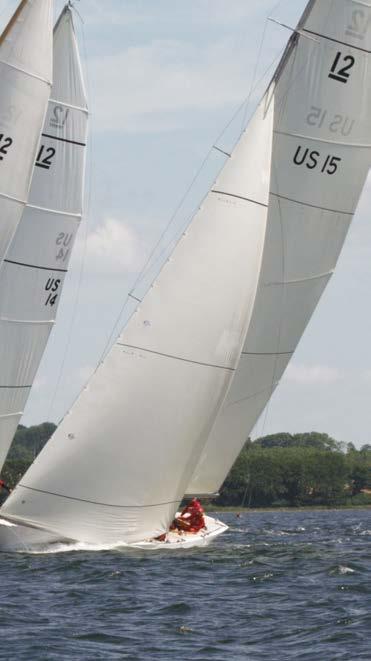

The 2022 edition of Volvo Cork Week held in July in Crosshaven saw 192 boats taking part in a full five-day programme of racing inside and outside Cork Harbour.
Racing took place on five separate courses with 14 di erent classes taking part, including the Classic Class, which enjoyed tremendous sailing in Mediterranean conditions on a series of windward/leeward courses o Roaches Point. A total of 18 classic yachts attended the regatta with nine entering the racing including two Cork One-Designs: Elsie owned by Patrick Dorgan and Jap, which was helmed by Harold Cudmore for the week.
The 2022 classics regatta was the result of the postponed Cork 300 event, which had been scheduled for 2020. Colin Moorhead the Admiral of Royal Cork Yacht Club at the time felt there was an opportunity to capitalise on a burgeoning classic scene in southern Ireland. “The Atlantic Yacht Club in France had committed to a ‘Go to Cork’ initiative for 2020 and were keen to finally make it happen in 2022. “Our event in 2022 was very much a toe in the water but it was a great success and certainly bodes well for the future. We hope to make an announcement soon about a stand alone Cork Classic Regatta for 2025.”

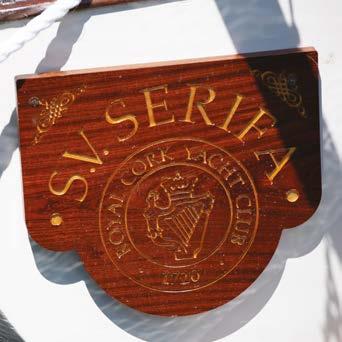
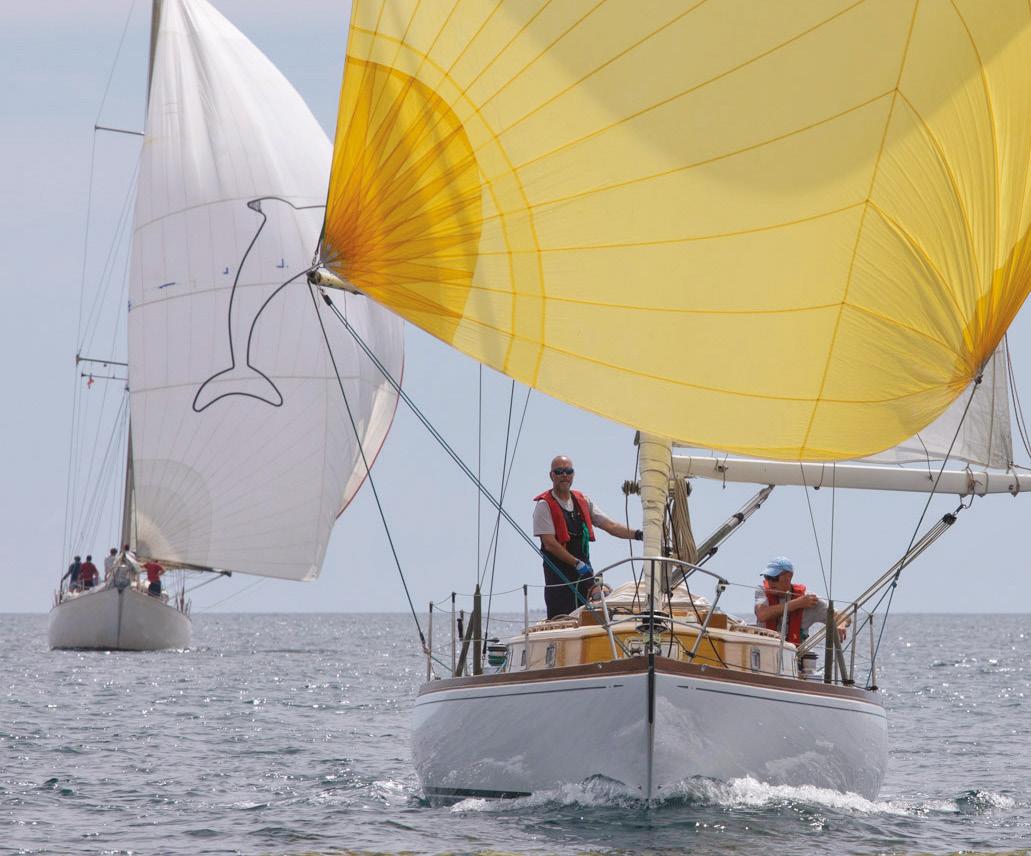

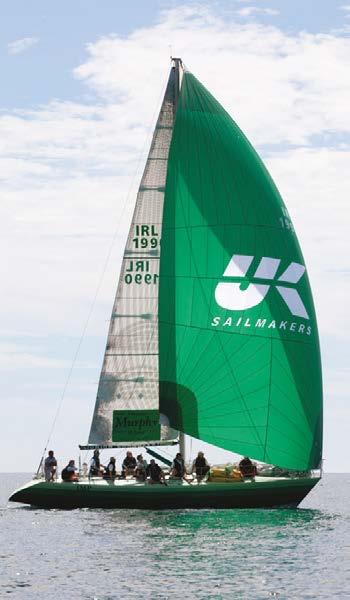
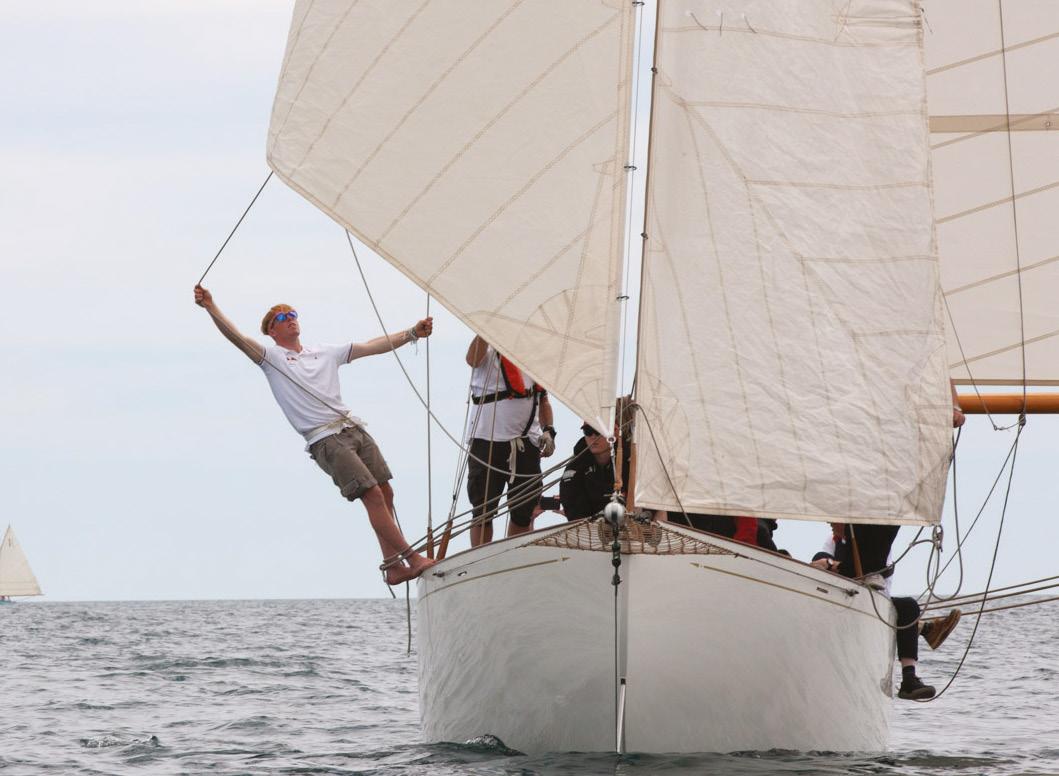
JJ Ollu’s French classic Bilou-Belle, from Atlantic YC, won the Classic Class by just two points from Patrick Dorgan’s Cork Harbour One-Design Elsie. Third was Dafydd Hughes’ Welsh S&S 34 Bendigedig, which also won the Prince of Wales 300th Anniversary Trophy. “The Prince of Wales Trophy is going to Wales!” commented Dafydd Hughes. “If the weather systems allow me, I will be racing Bendigedig around the world in the 2023 Global Solo Challenge.”
Other notable yachts at the regatta included local boat Lady Minn from Schull Harbour Sailing Club owned by Simon O’Keefe and Erin from the Royal Cork Yacht Club owned by Terry Birtles. Although not o cially in the Classic Class, the imperious Ron Holland-designed IMP looked glorious all week.
